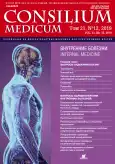THE ROLE OF GLYCEMIA SELF-CONTROL IN DECREASE OF THE RISK OF DIABETIC MICROAND MACROANGIOPATHIES? BEST PRACTICE
- Authors: Batrak G.A.1, Miasoedova S.E.1, Brodovskaia A.N.2
-
Affiliations:
- Ivanovo State Medical Academy
- City Clinical Hospital №4
- Issue: Vol 21, No 12 (2019)
- Pages: 55-58
- Section: Articles
- URL: https://journals.rcsi.science/2075-1753/article/view/95213
- DOI: https://doi.org/10.26442/20751753.2019.12.190631
- ID: 95213
Cite item
Full Text
Abstract
Full Text
##article.viewOnOriginalSite##About the authors
Galina A. Batrak
Ivanovo State Medical Academy
Email: gbatrak@mail.ru
д-р мед. наук, доц., проф. каф. терапии и эндокринологии Ivanovo, Russia
Svetlana E. Miasoedova
Ivanovo State Medical Academyд-р мед. наук, проф., зав. каф. терапии и эндокринологии Ivanovo, Russia
Anna N. Brodovskaia
City Clinical Hospital №4врач-эндокринолог Ivanovo, Russia
References
- Dedov II. Diabetes mellitus-a dangerous treat to the mankind. Vestn Ross Akad Med Nauk 2012; 1: 7-13.
- Auni G et al. Similarity of the impact of type 1 and type 2 diabetes on cardiovascular mortality in middle-aged subjects. Diabetes Care 2008; 31 (4): 714-9.
- Ruckert IM et al. Blood pressure and lipid management fall far short in persons with type 2diabe-tes: Results from the DIAB-CORE Consortium including six German population-based studies. Cardiovasc Diabetol 2012; 11 (1): 50.
- Pitocco D et al. Oxidative stress, nitric oxide, and diabetes. Rev Diabet Stud 2010; 7 (1): 15-25.
- Kitasato L et al. Postprandial hyperglycemia and endothelial function in type 2 diabetes: focus on mitiglinide. Cardiovasc Diabetol 2012; 11: 79.
- Radermecker RP et al. Blood glucose control and cardiovascular disease in patiens with type 2 diabetes. Results of ACCORD, ADVANCE and VA-Diabetes trials. Rev Med Liege 2008; 63 (7-8). 511-8.
- Ginsberg HN et al. Effects of Combination Lipid Therapy in Type 2 Diabetes Mellitus. The Action to Control Cardiovascular Risk in Diabetes (ACCORD Study Group). N Engl J Med 2010; 18.
- Fuchtenbusch M, Hummel M. Intensive blood sugar treatment in type 2 diabetics: no evidence for increased mortality in the ADVANCE study compared with ACCORD study, MMW. Fortschr Med 2008; 150 (17): 42-4.
- Cefalu WT, Watson K, Cefalu WT. Intensive glycemic control and cardiovascular disease. Observations from the ACCORD study. Diabetes 2008; 57: 1163-5.
- Patel A et al. Intensive blood glucose control and vascular outcomes in patients with type 2 diabetes. N Engl J Med 2008; 358: 2560-72.
- Алгоритмы специализированной медицинской помощи больным сахарным диабетом. Под ред. И.И. Дедова, М.В. Шестаковой, А.Ю. Майорова. 9-й вып. М., 2019. @@Algorithms for specialized medical care for patients with diabetes mellitus. Ed. I.I.Dedov, M.V.Shestakova, A.Yu.Mayorova. 9th issue. Moscow, 2019. (in Russian).
- Duckworth W et al. Glucose control and vascular complications in veterans with type 2 diabetes. N Engl J Med 2009; 360: 129-39.
- Dluhy RG, McMahon GT. Intensive glycemic control in the ACCORD and ADVANCE trials. N Engl J Med 2008; 358 (24): 2630-3.
- Бродовская А.Н., Батрак Г.А. Взаимосвязь вариабельности гликемии и поражения почек у больных с впервые выявленным сахарным диабетом 2 типа. Вестн. Ивановской медицинской академии. 2018; 23 (2): 48-9. @@Brodovskaia A.N., Batrak G.A. Vzaimosviaz' variabel'nosti glikemii i porazheniia pochek u bol'nykh s vpervye vyiavlennym sakharnym diabetom 2 tipa. Vestn. Ivanovskoi meditsinskoi aka-demii. 2018; 23 (2): 48-9 (in Russian).
- Климонтов В.В., Мякина Н.Е. Вариабельность гликемии при сахарном диабете: инструмент для оценки качества гликемического контроля и риска осложнений. Сахарный диабет. 2014; 17 (2): 190-9. @@Klimontov V.V., Miakina N.E. Variabel'nost' glikemii pri sakharnom diabete: instrument dlia otsenki kache-stva glikemicheskogo kontrolia i riska oslozhnenii. Sakharnyi diabet. 2014; 17 (2): 190-9 (in Russian).
- Bailey T et al. Diabetes Sci and Technol 2017; 11 (4): 736-43.
Supplementary files






